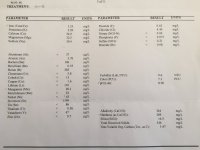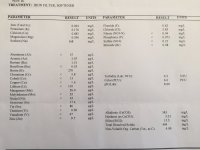Thanks MichealSK.
Hydrogen peroxide wold be a suitable oxidizer for the katalox lite. It is bactericidal, but its consumable costs are considerably higher than the NaClO. Disinfection byproducts aren't an issue.
This is what I was suspecting and was looking for an option that may not need more tanks.
I did post my water analysis in another post - copied here also.
Thanks Reach
After disinfecting with chlorine bleach, the water with the chlorine is pumped out and away. Any by-products should get flushed out with the chlorine, don't you think?
I was under the same impression.
So a little update:
I began to second guess myself as to where the stink was coming from.
Testing/sniff after Kl filter again seemed as if no smell or inconclusive
Prior test I drew water from test port after KL but believe I had the whole filtration system disco'd from main supply.
I have shut off's that completely isolate the filtration system so I can bypass all filters
Thinkin I may have been drawing water "backfeeding " from softener due to pressure in the filter complex?
I did not do a full sanitization after service (when I cleaned valves, replace softener resin and KL)
I put a few NaClO pellets in the well and let that circ into KL during regen hoping it would disinfect the KL a bit. flushed afterwards
Also performed a sanitization on the softener - stink was gone. was hopeful maybe I just needed to sanitize all.
3 days later - stink was back - cold side only again.
Next - Set my KL to backwash more often - daily, 10 min, 5.3 gpm DLFC on 9x48 vortec 1 cu ft)
So far so good.
Going on day 3 and no stink
fingers crossed .
I also have a 7 gpm DLFC ordered/in route - so may bump up BW gpm and see what that gets me. if needed
I was considering regen with NaCIO to see if that may fix the smell (as opposed to injecting full time, more tanks, carbon......)
I would need to reprogram and convert my Autotrol Logix 263 from filter to conditioner, add injector plug/line, brine tank and maybe use Cl pellets. See if that works.
Right now I am just trying to see if I can find a pattern.


